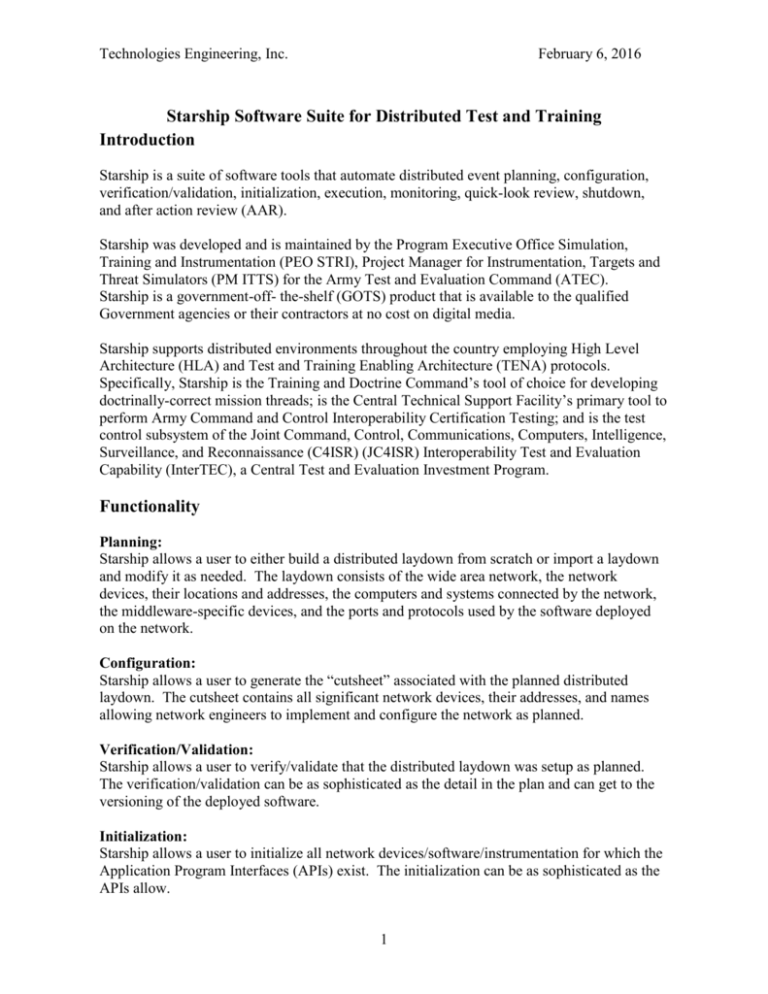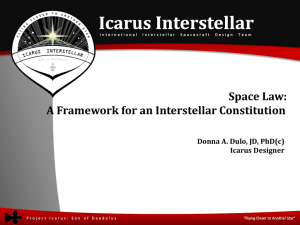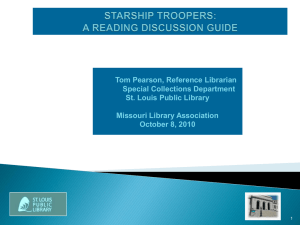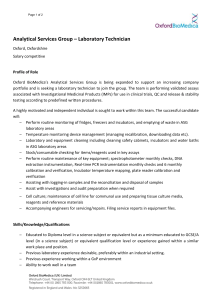Starship Software Suite for Distributed Test and Training
advertisement

Technologies Engineering, Inc. February 6, 2016 Starship Software Suite for Distributed Test and Training Introduction Starship is a suite of software tools that automate distributed event planning, configuration, verification/validation, initialization, execution, monitoring, quick-look review, shutdown, and after action review (AAR). Starship was developed and is maintained by the Program Executive Office Simulation, Training and Instrumentation (PEO STRI), Project Manager for Instrumentation, Targets and Threat Simulators (PM ITTS) for the Army Test and Evaluation Command (ATEC). Starship is a government-off- the-shelf (GOTS) product that is available to the qualified Government agencies or their contractors at no cost on digital media. Starship supports distributed environments throughout the country employing High Level Architecture (HLA) and Test and Training Enabling Architecture (TENA) protocols. Specifically, Starship is the Training and Doctrine Command’s tool of choice for developing doctrinally-correct mission threads; is the Central Technical Support Facility’s primary tool to perform Army Command and Control Interoperability Certification Testing; and is the test control subsystem of the Joint Command, Control, Communications, Computers, Intelligence, Surveillance, and Reconnaissance (C4ISR) (JC4ISR) Interoperability Test and Evaluation Capability (InterTEC), a Central Test and Evaluation Investment Program. Functionality Planning: Starship allows a user to either build a distributed laydown from scratch or import a laydown and modify it as needed. The laydown consists of the wide area network, the network devices, their locations and addresses, the computers and systems connected by the network, the middleware-specific devices, and the ports and protocols used by the software deployed on the network. Configuration: Starship allows a user to generate the “cutsheet” associated with the planned distributed laydown. The cutsheet contains all significant network devices, their addresses, and names allowing network engineers to implement and configure the network as planned. Verification/Validation: Starship allows a user to verify/validate that the distributed laydown was setup as planned. The verification/validation can be as sophisticated as the detail in the plan and can get to the versioning of the deployed software. Initialization: Starship allows a user to initialize all network devices/software/instrumentation for which the Application Program Interfaces (APIs) exist. The initialization can be as sophisticated as the APIs allow. 1 Technologies Engineering, Inc. February 6, 2016 Execution: Starship allows a user to build and execute threads that will orchestrate the execution of the event. The threads consist of conditionally linked commands based upon the APIs to all network devices/software/instrumentation. The threads can start, pause, restart, and stop network devices/software/instrumentation as well as put the network devices/software/instrumentation into the appropriate state consistent with the intent of the event stages. A user can execute individual commands and/or threads on an ad hoc basis. Monitoring: Starship allows a user monitor the status of all network devices/software/instrumentation and the execution of the event threads. The user can program thresholds on any reported property. The tripped thresholds can notify the user graphically or initiate thread execution. Quick-look review: Starship provides user-configurable, displays and reports that support network devices/software/instrumentation quick-look review and the analysis of trends. Shutdown: Starship allows a user stop, prepare, and harvest data from network devices/software/instrumentation either manually through individually issued Starship commands or by executing user-created execution threads. Starship allows the user to monitor the shutdown process graphically. AAR: Starship allows a user to perform an AAR from the test control perspective by presenting the planned execution and the actually-occurred execution. Starship can generate a report indicating what was done to include pertinent user entered additional information. Flexibility Starship XML Interface (StaX): In addition to prebuilt proprietary interfaces including standard HLA and TENA interfaces, Starship can interface with any network devices/software/instrumentation that uses the Starship XML (StaX) interface specification. StaX is unique in that it allows an instrument or application developer to build a custom Starship XML interface without any prior coordination with the Starship development team. This allows instrumentation software to be quickly modified to accommodate changing test requirements. Starship is distributed with the StaX software developers kit (SDK) and reference StaX application including source code. Starship SDK: In addition to the StaX SDK focused primarily on external interfaces, Starship has an “internal” SDK that allows relevant data to be added to the Starship execution (and its database). This enables Starship to present a richer user experience by leveraging data collect during event execution that is not reported directly to Starship. An example of this is the addition of tactical communication messaging traffic collected by instrumentation during 2 Technologies Engineering, Inc. February 6, 2016 Army interoperability certification testing. This allows Starship to present the planned vs. the actual mission thread on the same timeline. Operating System Agents (OS Agent): The OS Agent is a light-weight, optional, configurable console application that responds to remote commands and reports status information for the machine on which it is running. OS Agent interfaces with the operating system (e.g., Windows, Linux, and Solaris) to retrieve health-and-welfare status information such as available disk space, memory usage, CPU utilization, and much more. This information is gathered from remote machines at a userconfigurable interval and reported to Starship. In addition to viewing this status information, the Starship user can issue commands to any OS Agent causing it to initiate a pre-defined action on its local machine. Commands range from those related to the operation of OS Agent--such as start, stop, pause, and resume the reporting process--to broader-scoped commands--such as launch a process, terminate an already-running process or shutdown or reboot the machine. The broader-scoped commands are completely configurable by the user or system administrator of the local machine. Permission must be explicitly set in the OS Agent configuration file to allow someone to shutdown or reboot the system or to launch or terminate some or all processes. Integration Starship has also been used as an integrating and unifying user interface for a federation of complex applications that to use effectively would otherwise require a dozen subject matter experts. Starship is the user interface and performs the planning, configuration, verification/validation, initialization, execution, monitoring, quick-look review, shutdown, and AAR for the Command, Control, and Communications Driver federation of applications. Platform Starship is a modular, scalable application suite built on the Microsoft .NET platform and runs under the assorted Windows operating systems. For performance Starship utilizes an unmanaged C++ engine that performs low level data processing and data communications and employs the Microsoft MS SQL Server database management system for data storage and retrieval. Summary Starship is a Government-owned software suite used by the test and training communities to automate distributed event planning, configuration, verification/validation, initialization, execution, monitoring, quick-look review, shutdown, and AAR. Through user-configurable views and reports, Starship allows a user to orchestrate all aspects of a distributed event and provides fused information thereby reducing time, manpower, while increasing accuracy and situational awareness. 3






